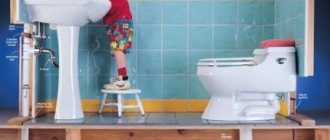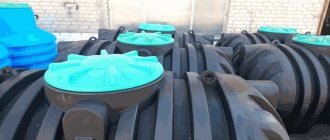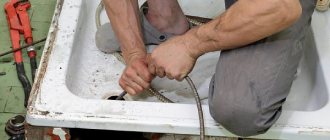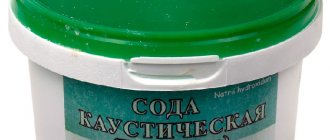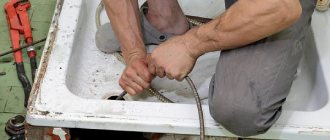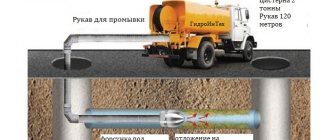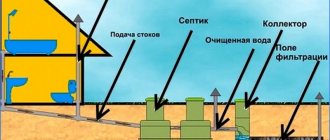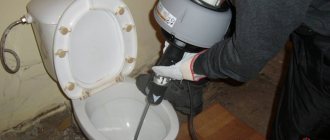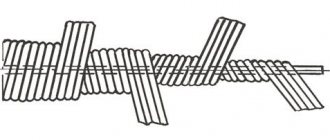A clog in a pipe can completely paralyze all household work, so you need to get rid of it as quickly as possible.
Of course, you can go to the store and buy an expensive pipe cleaner, but there is also a simpler and less expensive option - use improvised means that are found in every home.
Read the article below to learn how to clear clogs with baking soda and vinegar.
Will the remedies help cope with the problem?
Baking soda and vinegar can really clear up clogs. This effect is due to a special reaction that develops during their interaction. When soda and acid combine, 3 substances are released:
- water;
- carbon dioxide;
- sodium acetate.
Gas fills the space, displacing organics, grease and soap deposits that cause clogs, and water and sodium acetate only enhance this effect. Therefore, the combination of “soda + vinegar” can be used to combat traffic jams in pipes.
Rules for using funds
When the first signs of a blockage occur, determine the area where the problem arose. First, remove the siphon at the junction of the pipe and the device. Clean the element from contamination, open the hot water tap, and make sure that the liquid flows freely. If the flushing steps do not help, proceed to mechanical manipulation using a metal cable and a plunger. Upon completion of the work, use a solution consisting of soda and vinegar to better clean the inlet.
Precautionary measures
If the conditions when working with vinegar essence are not met, you can get chemical burns to the skin, damage to the respiratory organs, esophagus, and kidneys. Therefore, before using the strongest chemical element, precautions are taken.
Before the cleaning procedure, prepare protective equipment: rubber gloves, goggles, mask. The respirator must contain carbon to protect against vapors. Select special clothing with long sleeves to avoid contact of the substance with the skin of the hands. It is strictly forbidden to inhale vapors or taste the essence.
If you accidentally get sodium bicarbonate or vinegar on your skin, you should immediately run the area under running cool water. After cleaning the plumbing with caustic chemicals, carefully remove any remaining product.
Pros and cons of use
Baking soda and vinegar, as a means to combat blockages, have their advantages and disadvantages. Obvious benefits include:
The substances are safe for pipes. They can be used to treat metal and plastic waste, regardless of how old the installation was.- Safety for human health. Baking soda and vinegar are food preservatives, so when used correctly they are not harmful to the body.
- Quick effect. If the traffic jam is small, you can deal with it in 5-15 minutes.
- Elimination of unpleasant odor.
- Universal recipe. It can be used to treat sink, bathtub, kitchen sink, shower and toilet drains.
- Affordable price. A pack of soda and a bottle of vinegar will cost 40-50 rubles. While specialized products cost at least 150 rubles.
The main disadvantage is that soda and vinegar are not able to cope with complex blockages. They help eliminate only small plugs of hair, grease and soap.
Advantages and disadvantages of using funds
The main advantage of using these drugs is tangible economic benefits. These products can be found in almost any home; their cost compared to special cleaning products is ten times lower. It is also not difficult to purchase them; just visit the nearest store.
Baking soda in combination with acid acts as an anti-corrosion agent, removing rust marks and drips. They will not damage pipes made of any material: metal, plastic, cast iron.
Unlike advertised drugs based on chemical compounds, folk remedies do not harm the health of humans and animals. In addition, they significantly reduce the time for treatment, which takes from 5 minutes for prevention and up to 8 hours for complex blockages. The prepared solution effectively fights fat, eliminates plaque and unpleasant odors. Can be used for cleaning kitchen sinks, bathroom sinks and other plumbing fixtures.
Of the shortcomings, only one is highlighted - the inability to remove complex blockages that have formed due to inorganic debris. Only radical measures using aggressive means will help here.
How to clean the toilet?
A blockage in the toilet can form due to an excess amount of toilet paper, when personal hygiene products and even stale food get into the pipe. To cope with the problem, use baking soda and vinegar.
Features of the procedure:
- half a pack of soda is introduced into the drain;
- pour 500 ml of vinegar 9% into it;
- treat the surface of the toilet with a brush, paying special attention to the drain hole;
- lower the lid of the toilet seat and leave the mixture to act for an hour;
- Once again, go over the toilet with a brush and drain the water.
If the blockage is serious, it is recommended to wash off the mixture with hot (not boiling) water. Its maximum temperature is 50 degrees.
Basic rules and procedure for cleaning
Before cleaning the drain system, the following steps must be taken:
- Check the condition of the siphons. To do this, you need to unscrew the upper and lower rings of the siphon, disconnect it from the pipe and drain the water into a previously prepared container.
- To remove waste and large mechanical contaminants, you can use a plumbing cable, a plunger, or strong pressure of hot water.
- If these steps do not solve the problem of clogged pipes, you should start cleaning them with vinegar and soda.
From just two publicly available products, you can get three ways to clear a clogged drain.
First way
This method is designed to destroy greasy deposits on pipe walls. For cleaning you will need:
- ½ pack of baking soda;
- 100 ml vinegar (9%);
- 1-1.5 liters of boiling water;
- Rag;
Procedure:
- Remove as much water as possible from the clogged sink (bathtub). Pour baking soda into the drain hole.
- Then pour 100 ml of vinegar into it (it is better to warm it up a little to 40-45 degrees first).
- Plug the hole with a rag and wait at least 30-40 minutes.
- After the specified time has passed, fill the hole with boiling water.
If after cleaning the pipes with soda and vinegar the flow is still unsatisfactory, you can use this method again.
Second way
This option removes more complex blockages. To implement it you will need:
- 125 g baking soda;
- 125 ml vinegar (9%);
- 1 liter of boiled water;
- Rag or cork.
Procedure:
- Fill two glasses: one with vinegar, the other with soda. Mix the ingredients in a suitable container until foam appears.
- Pour the mixture into the pipe.
- Cover the drain area with a rag or stopper for 2 hours.
- After the specified time has passed, fill the hole with boiling water.
Third way
This method is relevant if the plug is deep in the pipe. To obtain the solution you need:
- 2-3 liters of hot water;
- Baking soda;
- Vinegar (9%).
Attention! The dosage of soda and boiling water is set at the following rate: 1 part soda to 3 parts boiling water. The amount of vinegar should be equal to the volume of soda.
Procedure:
- Fill the sink with water and leave for half an hour.
- Prepare a solution of soda and boiling water according to the above proportions, stir and, without cooling, pour into the drain hole.
- After 10 minutes, add vinegar.
- It is recommended to use the sink no earlier than after 2 hours.
Baking soda and vinegar in any form have an active effect on the cause of the blockage. However, to enhance the effect, it is recommended to use a plunger during the cleaning process (before adding the product and after the specified time has elapsed). It creates pressure differences, makes the waste more loose and facilitates the removal process.
Additional Information. Some housewives use caustic soda to clean pipes. This is a very powerful and aggressive agent that requires great care in use. When using it, no vinegar is added.
How to eliminate it in the sink?
The drain in the sink gets clogged especially often. To get rid of the blockage proceed as follows:
- The drain is plugged and the sink is filled with hot water.
- Grate laundry soap and pour it into the water. Stir the shavings until completely dissolved.
- Remove the plug and drain the water. Apply table vinegar to the sponge. Rub it on the walls of the sink. This method allows you to cope with dark spots and add shine to the surface. A little acid can be poured into the drain. This is done to disinfect it and get rid of the unpleasant odor.
- You can deal with lime deposits using soda. It is used to rub the areas where dishes and other kitchen utensils are located. The powder is spread over a damp surface, left for half an hour, and the sink is treated with a brush.
If the layer of limescale is dense and old, the sink is first moistened not with water, but with vinegar, after which soda is applied to the problem area. The exposure time of the substances is increased to 60 minutes.
The video will show you how to remove a clog in the sink with baking soda and vinegar:
Where do pipes clog most often?
The most problematic places where blockages form are the pipe from the kitchen sink . It constantly contains food residues and fat as accumulations. The filter on the drain is not always fully capable of protecting the structure from deposits.
A similar phenomenon is often observed in bathroom drain pipes . Usually the cause of clogged drains is hair that remains after washing your hair. The drain in the toilet, where hygiene items, rags, and baby diapers can get in, is also at risk.
We recommend: How to get rid of aphids in the garden - mustard and vinegar will help
Precautionary measures
When using caustic soda and acetic acid to combat blockages, you must take the following precautions:
- Carry out the cleaning procedure wearing a mask and goggles.
- Ventilate the room after treatment.
- Avoid contact of substances with skin and mucous membranes.
- Protect your hands with gloves.
- If soda or vinegar accidentally gets on exposed areas of the body, rinse them with plenty of warm water.
- Do not leave products in places accessible to children.
- After treatment, thoroughly rinse the pipes with hot water.
Briefly about the formation of blockages
During operation, liquid consisting of water, soap, shampoo and other personal hygiene products is washed down the drain. This greasy composition settles on the walls of the sewer outlet.
In addition, hair, animal hair, debris, lint from carpets or rugs, and other small particles penetrate the pipe. They stick to soap scum. Gradually, the layer of dirt grows, reducing the throughput of the drainage equipment.
If you do not clear the blockages in time, the plug will completely close the drain and water will stop flowing into the sewer.
If your bathroom pipes become clogged too often, you need to figure out why. There may be several of them:
- Improper use of plumbing equipment. Do not wash clothes that are too dirty in the bathtub. For example, rugs and carpets that have not been cleared of sand or dust. Bathing pets without first brushing out loose hair is also prohibited.
- Incorrect installation of plumbing equipment, i.e. insufficient slope of sewer pipes, as well as the presence of excessive bends that reduce the speed of water flow.
- Wear of drain channels (rust, holes).
Prevention
Measures aimed at preventing the formation of blockages in pipes:
Dishes should go into the sink without food residues - even small crumbs can cause a plug to form over time;- the drain hole must be protected by a grill; a mesh should be installed in the bathtub to catch hair;
- once a month, the drain is treated with soda and boiling water, using them in a ratio of 1:3;
- Do not flush personal hygiene products and food down the toilet; you need to make sure that a rag for washing the floor does not accidentally fall into the pipe.
Other drain cleaning methods
Above we looked at cleaning methods that involve a mixture of vinegar and soda. However, there are other techniques that involve adding other ingredients:
- Vinegar can be replaced with 100-150 g of regular salt mixed with 200-500 g of baking soda and boiling water. The resulting mixture is poured down the drain and another 1.5 liters of boiling water is poured. The composition is kept in the pipe for about 8-10 hours, and then thoroughly poured.
- Crystallized tartar can be added to the previous composition. Ratio: baking soda and table salt 1 cup each, cream of tartar - ¼ cup. All ingredients are pre-mixed and then poured into the drain. For 1 hour, add boiling water every 10-15 minutes, and at the end, pour cool water over the system.
- Vinegar can be replaced with a packet of classic citric acid, which is diluted in 1 tbsp. warm water. This amount is enough for 250 g of baking soda.
Helpful information
Tips to help deal with a clogged pipe:
- To increase the effectiveness of the procedure, after introducing the components into the pipe, it must be closed with a stopper. This will increase the pressure and the blockage will be eliminated completely.
- The following combinations cannot be used: “soda ash and baking soda”, “soda ash and vinegar”.
- If the blockage is dense, before introducing vinegar into the pipe, it is heated to 45-50 degrees.
- The longer the product remains in the pipe, the better, so it is recommended to apply the mixture at night or before leaving for work.
- Baking soda and vinegar are used as mono products. They are not combined with other chemicals as the reaction may be unpredictable.
If you are interested in how to clear a clog in a pipe, sink or toilet, take a look at this section.
Causes of blockages
Blockages in sewer pipes are a fairly common occurrence. There may be several reasons for this:
- Lack of slope of the sewer circuit towards the riser or, conversely, its redundancy, excessive tortuosity.
- Accumulation of fat and dirt insoluble deposits on the inner walls of pipes. Small debris is subsequently layered on it. This leads to a gradual narrowing of the passage opening, completely blocking the sewer flow and requires careful cleaning.
- The same effect occurs due to poor water quality. The minerals included in its composition form a limescale deposit, which only thickens over time.
- Particles of earth and sand washed from shoes into the sink, or foreign objects and household waste entering sewer pipes from a toilet or bathtub, accumulate in the recesses and cling to the joint elements, preventing the free passage of drains.
- Poor condition of the pipeline. Roughness of the walls, corrosion of cast iron pipes or careless installation of joints (fracture, protrusion of O-rings, tow) leads to the formation of irregularities in the internal circuit.
Additional mechanical methods to speed up problem solving
Along with chemical methods, blockages can also be removed mechanically. A plumbing plunger is used to push through the dirt plug, which is located near the drain hole.
At the end of the device there is a rubber cone-shaped bowl, which must be attached to the drain circuit. To ensure that the plunger fits tightly to the surface of the bathtub, the edges of the bowl can be lubricated with Vaseline.
Then you need to slowly make forward movements so that the air pushes the dirt plug. At the end of the procedure, direct a stream of water into the drain.
If the plug is located far from the drain hole, a plumbing cable is used, which consists of several twisted strands of wire with a hook or spiral at the end.
Insert the cable into the sewer pipe and twist it clockwise several times. Mechanical movements will allow debris to catch on the wire. Then remove the cable along with the plug.
Why do clogs appear?
Any pipes in the house can become clogged over time and lead to blockage. Especially if you use the drain carelessly, grease, large foreign particles and objects often get into it.
Blockages form faster if:
- The pipes are old and there are signs of corrosion and rust on their inner surface.
- The water drainage system is not assembled correctly - there are 90 degree angles and a slight difference in levels. When the soil subsides, the pipes bend, making it difficult for water to flow through them.
- The water is very hard, that is, it contains a lot of impurities of magnesium and calcium salts, which contribute to the formation of plaque.
- There are no siphons in which some of the solid particles are retained.
- Filters and grates are not installed on the drain hole in the kitchen sink.
- A lot of grease comes in when washing dishes.
- Preventative cleaning of pipes is not carried out.
If you eliminate the most common mistakes in using the sewer system, the risk of blockages will be minimal.
This means that there will be no smell in the kitchen from the sewer, and the water will drain easily. Problems in one apartment of a multi-story building automatically affect the state of the system in all others. It is easier to clear a small clog in the kitchen when the first signs appear, rather than wait for a global catastrophe with flooding.
How to tell if your drain is partially clogged
To make it easier to eliminate problems in the operation of sewer systems, you should not wait until the water completely stops leaving the sink or bathtub. You need to take urgent measures as soon as you notice the first signs of an impending problem:
- obvious deterioration in drainage (water drains much more slowly than usual);
- the appearance of an unpleasant odor.
The source of the stench emanating from the sewer is the rapidly multiplying colonies of bacteria in clogs. An unpleasant odor is a sign that microorganisms have entered the air.
Causes of deposits
The main causes of blockages are deposits on pipes, use of plumbing equipment for purposes other than its intended purpose, and gross errors during installation work. If you do not deal with the issues of cleaning the inner surface of sewer pipes, then the accumulation of dirt will become stronger day by day. The sticky surface is able to attract and retain fats that do not dissolve with plain water.
An independent analysis of samples taken from city pipes was carried out in laboratory conditions. Chemical analysis of sediment in water pipes showed that the blockage is an accumulation of chemicals: calcium, iron, organic compounds, limestone and much more. Thus, we can conclude: blockage can arise not only from external debris, but also from the quality of tap water.
Method number 4 - vinegar + Alka-Seltzer
It can effectively replace Alka-Seltzer soda. The drug will allow you to cope with minor blockages, as well as eliminate the unpleasant odor coming from the sewer.
You will need:
- Alka-Seltzer - 2 tablets;
- table vinegar - 1 glass;
- hot water.
What do we have to do:
- Pre-prepare the siphon by cleaning it according to the previously indicated scheme.
- Place 2 Alka-Seltzer tablets into the drain hole.
- Pour the preparation with one glass of vinegar for 2 minutes.
- Pour boiling water or hot water down the drain.
- Check the effectiveness of the procedure. Repeat if necessary.
Why does plaque form?
To understand how to clean a toilet at home, you need to determine what type of contamination is most important in your case. There are few difficult-to-remove contaminants, usually they are the following.
- Urine stone. It consists of complex mineral salts that fall onto the surface of the toilet bowl and under the rim with urine. Often the problem appears in families where household members forget to flush the toilet or the toilet itself is rarely subjected to preventive treatment. If a urinary stone has already formed, it is difficult to get rid of it; conventional means do not cope well with it.
- Limescale. In homes with high water hardness, the calcium salts it contains eventually settle in the tank and on the walls of the toilet. Various other types of contaminants quickly accumulate on top of the limescale. To whiten the toilet, in this case, acid-based products are used.
- Rust. The appearance of rusty streaks is also associated with water quality. This could be old, rusty water pipes or water with a high iron content from a well.
Mechanical damage to earthenware contributes to the accumulation of dirt. There is no need to wash the surface of the toilet bowl and cistern with metal brushes or coarse abrasive materials. Also, you should not pour hot water into the toilet - this will cause microcracks to form on the surface.
To improve water quality, various filters are used or preventive agents are constantly added to the toilet cistern in the form of special blisters and tablets.
Basic cleaning methods determine the source
It will be possible to choose the most effective way to combat pollution of this kind only after it is possible to establish the reasons for its occurrence, chemical composition, and so on.
Limescale
Limescale deposits in the toilet bowl are formed due to the accumulation of mineral compounds under the rim, which are found in very large quantities in tap water.
In some cases, leaks occur in places where water drains. They are yellow or orange in color. The activity of their occurrence directly depends on how often the water is washed off there.
If you leave deposits on the nozzles through which water enters the tank, they will become clogged over time, which, in turn, will lead to an increase in the time it takes to fill the tank.
Urine stone
Urine stone is also a plaque similar to calcareous deposits, but it has a completely different nature. It is a mineral substance that is excreted from the human body along with urine. The stone is painted in a dirty yellow color, in some cases it can have a gray color. If a ceramic product has certain irregularities on the inside, then the stone will form there.
To prevent the stone from starting to form in the toilet bowl, even at the time of purchase you should check how smooth the surface inside this ceramic product is. It is best to give preference to sanitary porcelain. Its cost is slightly higher compared to earthenware, but its structure is more dense - this can be achieved largely due to the fairly high temperature at which this product is fired. This material has excellent performance characteristics:
- due to its density, it will not accumulate limescale;
- smooth texture does not give yellowness from urinary stones;
- Such a surface will be much easier to clean and wash even with improvised means.
The key reason for the appearance of various deposits is the lack of preventive cleaning. When the product takes on a neglected appearance, the question of how to clean the toilet from rust and other deposits is much more difficult to solve. If you wash it regularly, it will retain its original appearance for a long time.
Caustic soda for drain cleaning
Caustic soda (caustic soda) is an aggressive toxic substance that is often used to remove blockages in the home.
When working with it, it is imperative to protect the respiratory tract, eyes and skin to avoid chemical burns. For protection, splash-proof goggles, a mask, rubberized or thick clothing and long rubber gloves are used.
If the product gets into your eyes, wash them with running water. If the solution gets on the skin, wash the affected area with plenty of water and lubricate it with a 2% solution of boric acid. If necessary, seek medical help.
To clean the sewer, you need to prepare 2 kg of powdered caustic soda, a thick-walled plastic bucket with a volume of 10 liters, and a scoop.
Mode of application:
- Caustic soda is poured into a bucket.
- Carefully pour cold water to half the volume of the bucket or a little more.
- The liquid is stirred until the powder is completely dissolved (it will heat up during the chemical reaction).
- The resulting solution is carefully poured into the drain hole.
- They wait 2-3 hours without using plumbing.
- Rinse the drain with cold water under strong pressure for 15-20 minutes.
Frequent use of caustic soda harms even the most durable surfaces, so use it only when absolutely necessary.


